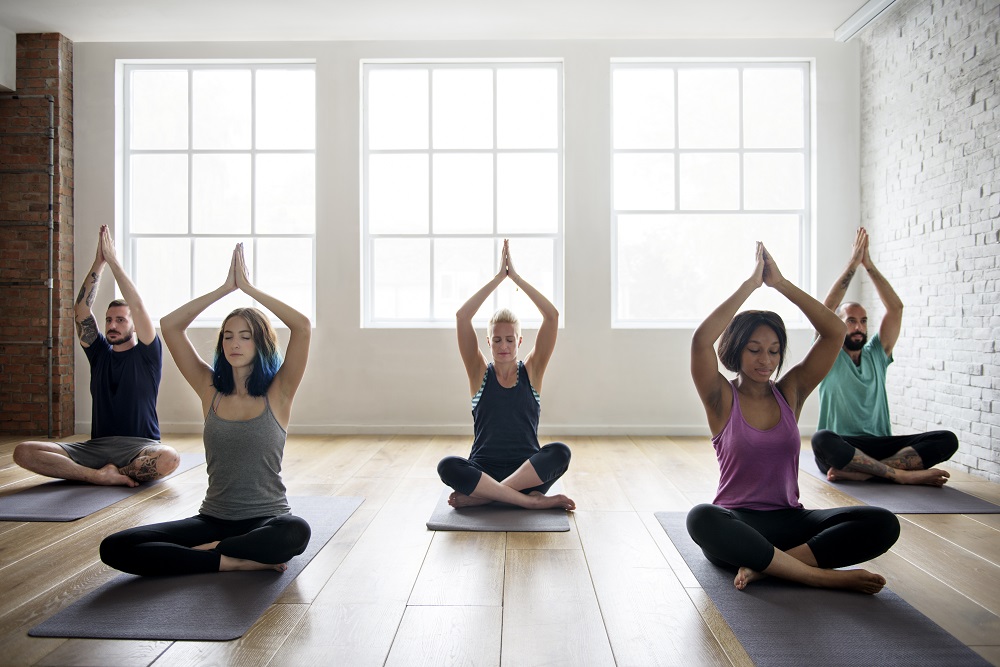
Thousands of years ago in the ancient world, in northern India, a group of men isolated in the density of a forest to search for solace and peace. What they discovered at that moment is that their inner experience, consisting of thought and emotions, was causing them anxiety and had no real practical purpose. They understood that when they stop feeding their thoughts, their mind becomes quiet.
This is the core understanding of what meditation is based on, and it has become an indispensable weapon against anxiety and stress over time. One of the branches of meditation is yoga, an ancient practice that combines slow movements with deep breathing.
These two have a crucial role in clearing the mind and releasing pain, as the ancients believed that energy gets stuck in our muscles and creates tension in our bodies.
Now that we broadly established what yoga is, let’s have a closer look at its benefits.
Stress relief
As we mentioned before, one of the main advantages of this practice is that it can decrease a significant amount of stress. In addition, yoga practitioners believe in the so-called “power of posture.”
They observed that, by sitting up straight, it would be more likely for us to remember positive memories than negative ones, and it will reinforce confidence in ourselves. In addition, by standing up straight, our testosterone levels (happy hormones) will increase, while the cortisol level (the primary stress hormone) will decrease.
Many people initiated practicing yoga as a method to reduce inflammation in their bodies. Many doctors have strongly recommended this method as a method of unconventional therapy for some types of immune responses of the body that can cause, over time, the development of pro-inflammatory diseases, such as diabetes and cancer.
Heart patch
In a recent study, it has been shown those who practice yoga constantly are more prone to lower levels of inflammatory markers, having the same amount of stress in their environments as those who preferred not practicing.
In addition to this, yoga proved to be an efficient help in improving heart health. Besides being great at stress relief, practicing yoga helps lower blood pressure, blood cholesterol, and blood glucose level. An article by Everyday Health shows us how this type of sport and meditation plays a crucial role in managing hypertension and decreasing both systolic and diastolic blood pressure (the top and the bottom on a blood pressure reading).
Furthermore, practicing yoga is good for battling atrial fibrillation/afib, an abnormal heart rhythm characterized by rapid and irregular beating leading to stroke or other complications. Studies show that patients following a yoga practice had experienced fewer episodes of afib.
Less headaches
On the other hand, if we mentioned the heart, we could as well mention the benefits for the head. Yoga reduces migraines, which are well-known by at least 1/7 of Americans. Migraines are characterized by severe throbbing pain or a pulsing sensation, activated by diverse triggers, such as sleep changes, stress accumulation, physical factors, or sensory stimuli.
Traditionally, medication can diminish migraines, but yoga proved to be a helping hand as well. According to Healthline, a 2007 study divided 72 patients into a yoga therapy and a self-care group for three months. After the end of the study, they concluded that yoga helped reduce headaches intensity, frequency, and pain, compared with the other practice.
Improving balance
Another benefit of yoga is that it improves your balance. Proprioception, the ability to feel what your body is doing and where it is in space, is naturally increased during yoga and the balance of the body. Why is it important to train your balance? First of all, it is essential because it is great for body control and coordination.
It allows you to achieve outstanding precision and accuracy of movement.
Body & brain
Moreover, balancing series in yoga training not only are helping with strength and ability but are also great for the brain. They strengthen the brain’s networks and thus improve mental efficiency, concentration, focus, and alertness. Training and meditation also require determination and perseverance, leading to improved mental resilience.
In addition, it increases coordination, body control, and agility by activating neuromuscular communication during the workout.
As with any other sport, yoga pushes its practitioners to gain a better quality of sleep.
After a good yoga practice, your body is more relaxed, and you are prone to sleep faster and more profound than before and wake up more well-rested and ready to start the day. In addition, if you start practicing yoga, you can wave goodbye to anxiety, depression, and stress, the significant factors of sleep disorders.
Better quality of life
Above all the healthy and psychological benefits mentioned above, yoga improves the quality of life. It’s been a great help battling cancer by decreasing the symptoms of chemotherapy, such as nausea, vomiting, pain, and fatigue. Studies show that cancer patients who chose to practice yoga had a better acceptance and felt more invigorated and relaxed.
Yoga helps improving sleep quality, enhances well-being and a positive attitude towards daily activities. It also promotes healthy eating habits, encourages weight loss, and helps treat eating disorders by decreasing episodes of binge eating and increasing physical activity.
During the pandemic, I tried yoga. I was facing, like everybody else, a first-time experience where I was obliged to stay indoors for an indefinite amount of time. In need of activity, I remembered that yoga requires very little space and no additional instruments, so I started practicing it.
After 100 days of yoga, I realized I was coping with the idea of lockdown way better than my friends. I was losing weight; I was sleeping like a baby and had a good mood every morning. By the end of the first lockdown, I succeeded in reaching the next level of my practice, increasing mobility and better resilience to the exercises.
In conclusion, yoga is for everyone. It only requires patience and understanding, and you will only wait so little until you see the benefits.
You might also like: 8 Tips to Follow Before Taking Your First Yoga Class

























